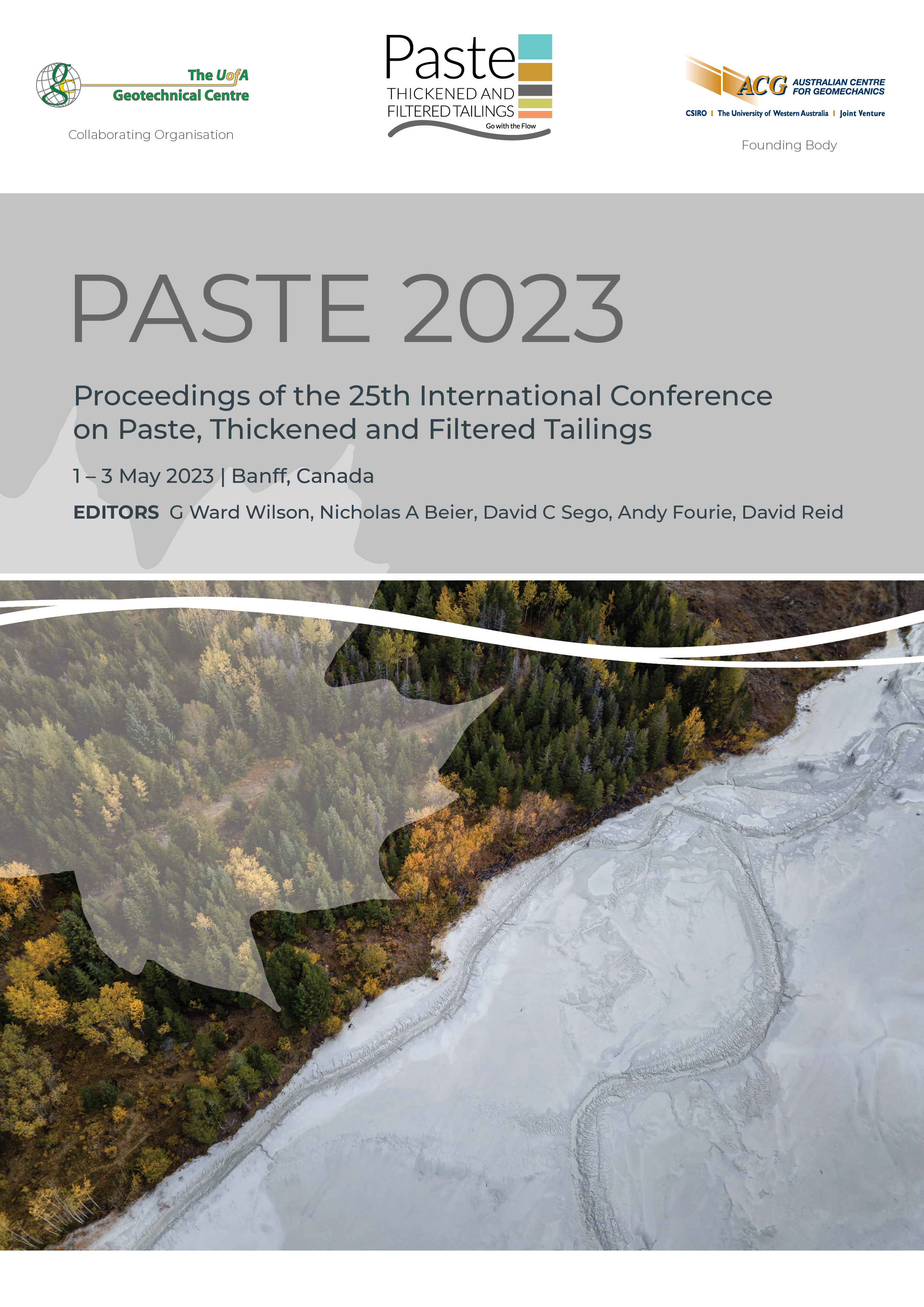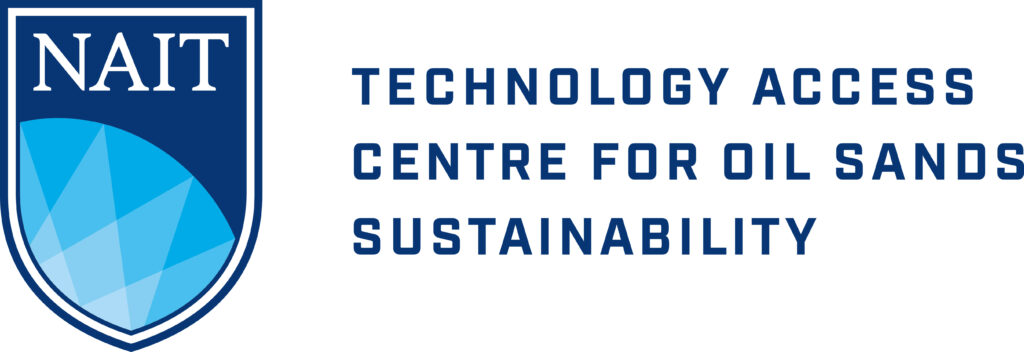Experimental validation of a prediction model of the compressive strength of cemented rockfills

|
Authors: Rafraf, G; Belem, T; Mrad, H; Gélinas, L-P; Krichen, A |
DOI https://doi.org/10.36487/ACG_repo/2355_67
Cite As:
Rafraf, G, Belem, T, Mrad, H, Gélinas, L-P & Krichen, A 2023, 'Experimental validation of a prediction model of the compressive strength of cemented rockfills', in GW Wilson, NA Beier, DC Sego, AB Fourie & D Reid (eds), Paste 2023: Proceedings of the 25th International Conference on Paste, Thickened and Filtered Tailings, Australian Centre for Geomechanics, Perth, pp. 841-852, https://doi.org/10.36487/ACG_repo/2355_67
Abstract:
Underground mine backfilling promotes solid waste to be returned as cementitious material either in the form of cemented paste backfill – CPB – (using tailings) or in the form of cemented rock fill – CRF – (using crushed waste rock, WR). The cement or binder addition is intended to develop a required unconfined compressive strength (UCS) value to ensure ground stability during mining operations. While CPB is the most common type of mine backfill used in underground mining operations, CRF is only used when high compressive strength is required to increase productivity. Despite the performance of CRF, this type of backfill is not much studied or optimised. The main objective of this study is to validate experimentally a newly developed semi-empirical model for predicting the UCS of CRF. This model considers various physical parameters of CRF materials such as the types of binder (e.g. general use Portland cement –GU, GU-fly ash, GU-ground granulated blast furnace slag, etc.) and their mass proportion (binder rate Bw), the water-to-cement ratio (W/C), the type of WR (according to its relative density DR) and the grain size distribution, and the curing time (t). To this end, numerous cylindrical CRF specimens are prepared by varying the W/C, the type of binder, the binder rate Bw (4–8%), the type of WR and the average diameter (d) of the particles. Preliminary results show that the accuracy of the predicted UCS values of various laboratory-prepared CRF mix recipes is satisfactory with a high coefficient of correlation (R 0.9). Therefore, it is reasonable to adopt the proposed CRF strength prediction model for laboratory-prepared specimens that can be scaled up in situ bydeveloping an efficient CRF preparation quality control (QC) procedure.
Keywords: unconfined compressive strength, cemented rockfill, semi-empirical prediction model, experimental validation, quality control
References:
Annor, AB 1999, A Study of the Characteristics and Behaviour of Composite Backfill Material, PhD thesis, McGill University, 396 p.
Arioglu, E 1984, ‘Design aspects of cemented aggregate fill mixes for tungsten stoping operations’, Mining Science and Technology, pp. 209–214.
ASTM 2006, Standard Test Method for Sieve Analysis of Fine and Coarse Aggregates (C136), ASTM International, West Conshohocken,
ASTM 2015, Standard Test Method for Relative Density (Specific Gravity) and Absorption of Fine Aggregate (C128-15), ASTM International, West Conshohocken.
ASTM 2021, Standard Test Method for Compressive Strength of Cylindrical Concrete Specimens (C39/C39 M), ASTM International, West Conshohocken.
Belem, T & Benzaazoua, M 2008, ‘Design and application of underground mine paste backfill technology, Geotechnical and Geological Engineering, vol. 26, no. 2, pp. 147–174.
Belem, T 2020, ‘Semi-empirical models for predicting the unconfined compressive strength of virtual uncemented rockfill (RF) and cemented rockfill (CRF), internal report, Research Institute on Mines and Environment, Montreal, 19 p.
Benzaazoua, M, Belem T & Bussière, B 2002, ‘Chemical aspect of sulphurous paste backfills mixtures, Cement and Concrete Research, vol. 32, no. 7, pp. 1133–1144.
Benzaazoua, M, Fall, M & Belem, T 2004, ‘A contribution to understanding the hardening process of cemented pastefill, Minerals Engineering, vol. 17, no. 2, pp. 141–152.
Farsangi, PN 1996, Improving Rockfill Design in Open Stoping, PhD thesis, McGill University, Montreal.
Farsangi, PN, Hayward, AG & Hassani, FP 1996, ‘Consolidated rockfill optimization at Kidd Creek Mines, CIM Bulletin, vol. 89, no. 1001, pp. 129–134.
Gonano, LP, Kirkby, RW & Dight, PM 1978, Triaxial Testing of Cemented Rockfill, technical report 72, Commonwealth Scientific and Industrial Research Organisation, Australia.
Gélinas, LP 2021, Current Knowledges on Arctic Cemented Rockfill (CRF) Cured in Permafrost Conditions, internal AEM document #6128-000-100-TCR-001, technical report.
Hane, I, Belem, T & Benzaazoua, M 2018, Cemented Rock Fill (CRF) Plant Laboratory Test Methods for Kirkland Lake Gold (KL), final report PU-2017-11-1172, 23 p.
Hane, I, Belem, T, Benzaazoua, M & Maqsoud, A 2017a, ‘Laboratory characterization of cemented tailings paste containing crushed waste rocks for improved compressive strength development,’ Geotechnical and Geological Engineering, vol. 35, no. 2, pp. 645–662,
Hane, I, Belem, T, Benzaazoua, M & Maqsoud, M 2017b, ‘Laboratory investigation into the compressive strength of cemented paste tailings aggregate fills’, in M Hudyma & Y Potvin (eds), UMT 2017: Proceedings of the First International Conference on Underground Mining Technology, Australian Centre for Geomechanics, Perth, pp. 363–373,
ACG_rep/1710_28_Hane
Hedley, DGF 1995, Final Report on the Stiff Backfill Project for M.R.D., Mining Research Directorate, Canadian Rockburst Research Program, Sudbury.
Lamos, AW & Clark, IH 1993, ‘The influence of material composition and sample geometry on the strength of cemented backfill’, Innovations in Mining with Backfill: Proceedings of the Fourth International Symposium on Mining Backfill, A.A. Balkema, Rotterdam, pp. 89–94.
Mitchell, R, & Wong, B 1982, ‘Behaviour of cemented tailings sands’, Canadian Geotechnical Journal, vol. 19, no. 3, pp. 289–295.
Stone, DMR 1993, ‘The optimization of mix designs for cemented rockfill’, Minefill, vol. 93, pp. 249–253.
Stone, DMR 2007, ‘Factors that affect cemented rockfill quality in Nevada Mines’, CIM Bulletin, vol. 100, no. 1103, pp. 1–6.
Villaescusa, E 2003, ‘Global extraction sequences in sublevel stoping’, Proceedings of the 12th International Symposium on Mine Planning and Equipment Selection, vol. 1, pp. 9–17.
Vennes, I 2014, Determination of Cemented Rockfill Strength with Large Scale UCS Tests Under In-situ Conditions, master’s thesis, McGill University, Montreal.
Yu, T 1989, ‘Some factors relating to the stability of consolidated rockfill at Kidd Creek’, Innovations in Mining Backfill Technology, CRC Press, Boca Raton, pp. 279–286.
© Copyright 2025, Australian Centre for Geomechanics (ACG), The University of Western Australia. All rights reserved.
View copyright/legal information
Please direct any queries or error reports to repository-acg@uwa.edu.au
View copyright/legal information
Please direct any queries or error reports to repository-acg@uwa.edu.au



